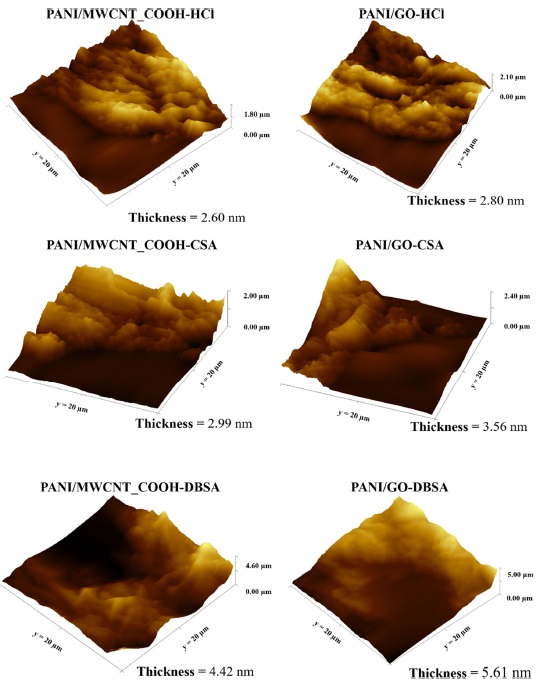 Abstract: This paper introduces a novel wearable flexible gas sensor designed specifically for the detection of d-limonene. The sensor utilizes materials recognized for their high efficiency-to-cost ratio, notably polyaniline (PANI) combined with carboxylated multiwalled carbon nanotubes (MWCNT) and graphene oxide (GO) as sensing layers. The study conducts a comprehensive analysis of the nanocomposite layers, examining their functional groups, morphology, topography, thickness, crystallinity, thermal behavior, surface area, as well as the size and volume of their pores. This examination showed distinctions among the nanocomposite layers. PANI/GO exhibited larger pore size and thickness, while PANI/MWCNT_COOH demonstrated a higher surface area. The analysis of thermal stability demonstrated that the film employing the DBSA dopant exhibited the lowest stability. Morphological characterizations showed a globular structure for PANI, tubular characteristics for PANI/MWCNT_COOH, and a flat nature for PANI/GO. When detecting d-limonene, nanocomposite films doped with HCl demonstrated notably superior response levels. The gas sensors exhibited high sensitivity (>2.24 mV/ppm), a narrow range for the limit of detection (0.12-0.52 ppm), and excellent reversibility, stability, and selectivity. These findings suggest the possibility of broadening the application of gas sensors to monitor additional volatile compounds, with a particular emphasis on the online monitoring of agricultural products. Abstract: This paper introduces a novel wearable flexible gas sensor designed specifically for the detection of d-limonene. The sensor utilizes materials recognized for their high efficiency-to-cost ratio, notably polyaniline (PANI) combined with carboxylated multiwalled carbon nanotubes (MWCNT) and graphene oxide (GO) as sensing layers. The study conducts a comprehensive analysis of the nanocomposite layers, examining their functional groups, morphology, topography, thickness, crystallinity, thermal behavior, surface area, as well as the size and volume of their pores. This examination showed distinctions among the nanocomposite layers. PANI/GO exhibited larger pore size and thickness, while PANI/MWCNT_COOH demonstrated a higher surface area. The analysis of thermal stability demonstrated that the film employing the DBSA dopant exhibited the lowest stability. Morphological characterizations showed a globular structure for PANI, tubular characteristics for PANI/MWCNT_COOH, and a flat nature for PANI/GO. When detecting d-limonene, nanocomposite films doped with HCl demonstrated notably superior response levels. The gas sensors exhibited high sensitivity (>2.24 mV/ppm), a narrow range for the limit of detection (0.12-0.52 ppm), and excellent reversibility, stability, and selectivity. These findings suggest the possibility of broadening the application of gas sensors to monitor additional volatile compounds, with a particular emphasis on the online monitoring of agricultural products. |




 Abstract: This paper introduces a novel wearable flexible gas sensor designed specifically for the detection of d-limonene. The sensor utilizes materials recognized for their high efficiency-to-cost ratio, notably polyaniline (PANI) combined with carboxylated multiwalled carbon nanotubes (MWCNT) and graphene oxide (GO) as sensing layers. The study conducts a comprehensive analysis of the nanocomposite layers, examining their functional groups, morphology, topography, thickness, crystallinity, thermal behavior, surface area, as well as the size and volume of their pores. This examination showed distinctions among the nanocomposite layers. PANI/GO exhibited larger pore size and thickness, while PANI/MWCNT_COOH demonstrated a higher surface area. The analysis of thermal stability demonstrated that the film employing the DBSA dopant exhibited the lowest stability. Morphological characterizations showed a globular structure for PANI, tubular characteristics for PANI/MWCNT_COOH, and a flat nature for PANI/GO. When detecting d-limonene, nanocomposite films doped with HCl demonstrated notably superior response levels. The gas sensors exhibited high sensitivity (>2.24 mV/ppm), a narrow range for the limit of detection (0.12-0.52 ppm), and excellent reversibility, stability, and selectivity. These findings suggest the possibility of broadening the application of gas sensors to monitor additional volatile compounds, with a particular emphasis on the online monitoring of agricultural products.
Abstract: This paper introduces a novel wearable flexible gas sensor designed specifically for the detection of d-limonene. The sensor utilizes materials recognized for their high efficiency-to-cost ratio, notably polyaniline (PANI) combined with carboxylated multiwalled carbon nanotubes (MWCNT) and graphene oxide (GO) as sensing layers. The study conducts a comprehensive analysis of the nanocomposite layers, examining their functional groups, morphology, topography, thickness, crystallinity, thermal behavior, surface area, as well as the size and volume of their pores. This examination showed distinctions among the nanocomposite layers. PANI/GO exhibited larger pore size and thickness, while PANI/MWCNT_COOH demonstrated a higher surface area. The analysis of thermal stability demonstrated that the film employing the DBSA dopant exhibited the lowest stability. Morphological characterizations showed a globular structure for PANI, tubular characteristics for PANI/MWCNT_COOH, and a flat nature for PANI/GO. When detecting d-limonene, nanocomposite films doped with HCl demonstrated notably superior response levels. The gas sensors exhibited high sensitivity (>2.24 mV/ppm), a narrow range for the limit of detection (0.12-0.52 ppm), and excellent reversibility, stability, and selectivity. These findings suggest the possibility of broadening the application of gas sensors to monitor additional volatile compounds, with a particular emphasis on the online monitoring of agricultural products. @article={003207784,author = {GRABOSKI, Adriana Marcia; FELTES, Giovana; PASCHOALIN, Rafaella Takehara; STEFFENS, Juliana; PAROUL, Natalia; STEFFENS, Clarice.},title={Gas-sensing properties of polyaniline-based nanocomposites for d-limonene detection},journal={Journal of Applied Polymer Science},note={v. 141, n. 35, p.e55878-1-e55878-11},year={2024}}
@article={003207784,author = {GRABOSKI, Adriana Marcia; FELTES, Giovana; PASCHOALIN, Rafaella Takehara; STEFFENS, Juliana; PAROUL, Natalia; STEFFENS, Clarice.},title={Gas-sensing properties of polyaniline-based nanocomposites for d-limonene detection},journal={Journal of Applied Polymer Science},note={v. 141, n. 35, p.e55878-1-e55878-11},year={2024}}